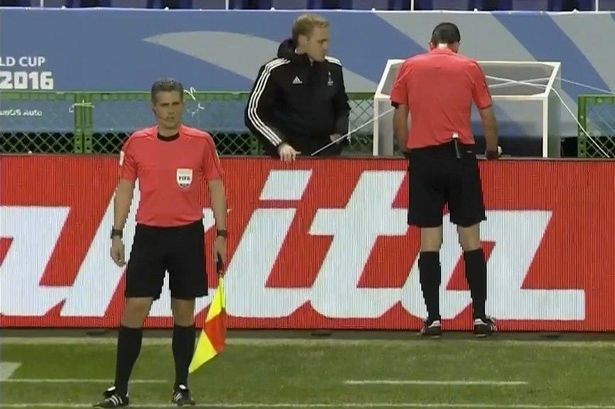Video Replay for referees makes World Cup better
Video-Assisted Referees is expected to make soccer better.
Change Size
 Match Referee, Viktor Kassai, uses the video assistant referee to make a decision. (Youtube/File)
Match Referee, Viktor Kassai, uses the video assistant referee to make a decision. (Youtube/File)
S
occer can be annoying, especially to those who watch only the big tournaments. There are too many fouls, baffling referee errors and players without a scratch on them rolling in the grass as if in unbearable pain — and too few goals. But the 2018 World Cup has been surprisingly different (with a few exceptions). The improvement probably comes down to a single rule change: Referees now have access to video replays.
A little more than a week into the monthlong competition, it’s too early to know for sure how much the technology called Video-Assisted Referees will change the game. But there are signs it’s making it better. So far, there have been fewer serious fouls than usual and no referee errors that affected match outcomes. In addition, compared with previous World Cups, the players appear to be more singularly focused on scoring or preventing goals, and less on hurting and intimidating opponents or trying to trick referees into favorable decisions.
Replays have been used to settle disputes in US professional sports for years, but soccer is extremely conservative and every tweak to the rules causes a controversy because players and coaches consider the game perfect as it is. But some innovations turned out to be very effective. For example, the 2006 decision that referees should send off players for deliberately elbowing opponents to the head reduced head injuries by 29 percent.
The introduction of Video-Assisted Referees, know as VAR, to the World Cup for the first time this year was hotly contested, though. Soccer is a defiantly analog, pointedly democratic game that’s played and loved as much in poor countries as rich ones. VAR is a rich-country addition. It has been tested, for one season, in some wealthy leagues, including in Germany and Italy, where it wasn’t an unqualified success. In both countries, fans complained about long decision times of two minutes or more while referees stopped play to consult monitors.
By mid-season, delays had been reduced. Still, in one German game, after reviewing play thanks to VAR, the referee recalled the teams from the halftime break to take a penalty kick. In a high-stakes game in Australia, the technology broke down at a crucial moment, and a winning goal that should have been disallowed was counted. In Italy, a stubborn referee repeatedly overruled the technology, making outcome-changing errors.
Nonetheless, statistics from the trials show that VAR has achieved some important results. In the Italian Serie A last season, it reduced the percentage of mistaken referee decisions to 1 percent from 6 percent. At the same time, the number of fouls dropped by 8.8 percent, the number of yellow cards for serious fouls by 14.7 percent and the number of dives, or fake fouls, by 43 percent.
The technology seems to be paying off in the 2018 World Cup. There is no talk of the kind of disastrous referee errors that plagued previous tournaments. VAR doesn’t remove all subjectivity from the decisions of referees, who assess the situation on the screen as best they can. Bit it gives them the capacity to have the same vantage point as fans watching TV at home, ensuring there are no blatant miscalls or oversights.
A Leuven University paper published just before the World Cup shows that referees who watch bits of the game in slow motion tend to be stricter when meting out punishment: They are more likely to see fouls as reckless or intentional than accidental. If players sense that nothing will escape the referee, they should be less likely to commit fouls.
Anyone who has watched most of the games so far will have noticed that players spend less time simulating injuries than at previous World Cups, and that there’s surprisingly little dirty play (though the Brazilian star Neymar would probably object: In his team’s first game against Switzerland, he was fouled on 10 times, the most of any player in World Cup history). Nonetheless, yellow and red card statistics indicate that this may turn out to be the nicest World Cup in at least two decades.
One of soccer’s more frustrating qualities for viewers is that goals are often few and far between. The 2018 World Cup is the first since 1954 in which there haven’t been any scoreless draws in the first 20 games. The average number of goals scored in a game in the last seven World Cups was 2.48. This time, between the beginning of the competition on June 14 and the end of June 20, the average was 2.25. Given that the number of goals scored in a game usually increases because of penalty shootouts in the final, knockout stage of the tournament, this World Cup also has the potential to be the most goal-rich competition since at least the 1980s.
There’s no obvious connection between the introduction of VAR and the more competitive nature of the games in Russia. Yet there may be a deeper link. Soccer can be a below-the-radar dirty game, in which players set out to hurt each other in ways that escape the scrutiny of referees. With VAR, a special team watching the game from many camera angles can alert the referee on the field that something ugly is going on. It’s almost pointless, or at least more risky, to start sneaky violence campaigns. So players concentrate harder on fair-play competition.
That, of course, is just one viewer’s theory. But then, there have been no other major changes at this World Cup to explain why it has been decidedly different from its predecessors and, on average, a better spectacle.









